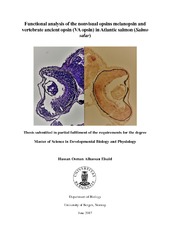Functional analysis of the nonvisual opsins melanopsin and vertebrate ancient opsin (VA opsin) in Atlantic salmon (Salmo salar)
Master thesis
Permanent lenke
https://hdl.handle.net/1956/16028Utgivelsesdato
2017-06-15Metadata
Vis full innførselSamlinger
Sammendrag
The role of nonvisual photoreceptors is yet to be elucidated regarding the link to biological function. This study aims to characterise the expression pattern of melanopsin and vertebrate ancient opsin during early developmental stages of Atlantic salmon, and to relate the function of these genes to hatching. Fertilised salmon’s eggs were subjected to different light qualities using LED technology where intensity and spectrum was manipulated. Two light regimes, 24 hours of continuous light (LL) and 14 hours of light:10 hours of darkness (LD) of white light of different intensities, high, medium, and low, beside different light spectrum of the same intensity, deep red, amber, green, blue, royal blue, and ultra violet were used. Continuous dark was used as a control. Eggs were monitored during the study period and hatched eggs recorded. In situ hybridization technique was used to characterise the expression of two nonvisual opsin, the vertebrate ancient opsin (VA) and melanopsin. The results from hatching experiment show that, while continues white light and LD cycles of white light of the medium intensity increase the hatching period (span), LD cycles of the low intensity white light decease it significantly. However, the time to 50% of hatching is significantly increased by LD cycles of green light blue light, and low intensity of white light. The results from the expression experiments has shown that both melanopsin and VA opsin are expressed in the brain of salmon during the early developmental stages. Both were found in the left habenula, thalamus, hindbrain and spinal cord. Moreover, they have been found to be colocalised in several regions in the brain. Furthermore, regional specific neural activation was found in the habenula and hindbrain, where melanopsin and VA opsin are co-localized, upon light stimulation. This indicate direct photoreception in these brain regions already around hatching. The result indicates that, apparently, the hatching process in salmon may be affected by light to some degree, but there is no strong inhibition of hatching by light such reported for Atlantic halibut. Other factors like the temperature and low levels of oxygen might be other environmental cues that are used by Atlantic salmon to regulate the time of hatching. The nonvisual system is clearly developed and functional prior to hatching and may be part of the regulation of hatching. The specific nonvisual hindbrain cluster found to regulate hatching in Atlantic halibut are not apparent in salmon. Our data clearly shows the important of nonvisual photoreception in the brain at early developmental stages of fish, prior to development of functional eyes. There seems to be species-specific patterning of the nonvisual photoreceptors in the brain, which indicates species specific tailoring of biological function.
